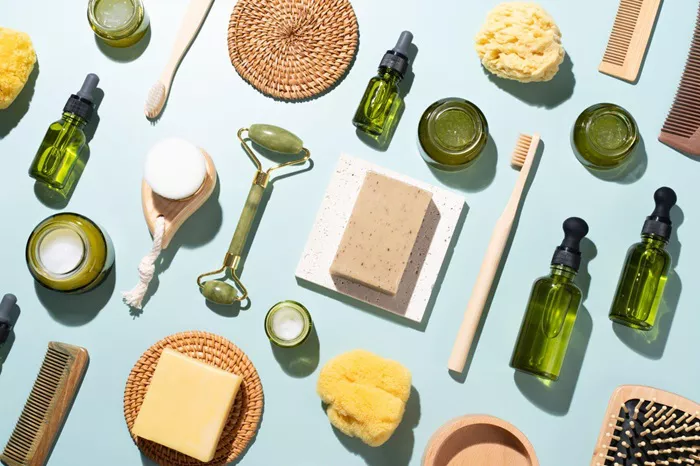As the beauty industry undergoes a significant transformation, consumers are increasingly prioritizing sustainability over fleeting trends. With growing concerns over climate change and ethical issues, beauty routines are evolving to not only focus on personal health but also on minimizing environmental impact. In 2025, embracing sustainable beauty is no longer just a choice, but a responsibility—both personal and collective.
Sustainable Beauty Starts with Ingredients
Sustainability in beauty products begins at the ingredient level. More brands are now choosing plant-based and responsibly sourced ingredients to create eco-friendly formulations. Natural alternatives like bakuchiol—a plant-based substitute for retinol—and marine algae, which is known for its hydrating properties, are gaining popularity for their ability to replace synthetic chemicals while supporting biodiversity.
Another significant shift is the move away from animal testing and animal-derived ingredients. Innovative cruelty-free formulations are taking center stage, offering products that are not only kinder to the planet but also free from allergens and irritants that can harm sensitive skin.
The Rise of Waterless Beauty
As water scarcity becomes an increasing global concern, the beauty industry is embracing “waterless” beauty products. These products, including solid cleansers, powdered masks, and concentrated serums, offer effective skincare solutions without relying on water as a primary ingredient. The shift to waterless beauty helps conserve water during production, while also extending the shelf life of products.
Additionally, mineral-based sunscreens that contain non-nano zinc oxide or titanium dioxide are emerging as safer alternatives for both skin and marine ecosystems, providing broad-spectrum protection without harming aquatic life.
Trending Now: Skinimalism and Eco-Friendly Packaging
The “skinimalism” trend continues to rise as consumers opt for simpler, high-quality beauty routines. Multi-functional products, such as tinted moisturizers with SPF or serums that hydrate and brighten, are reducing the need for excessive packaging and simplifying skincare routines.
Packaging waste remains one of the beauty industry’s most significant challenges. To address this, brands are increasingly adopting refillable systems, compostable materials, and recyclable options. Glass containers and metal tubes, which are more sustainable alternatives to plastic, are becoming the norm for eco-conscious brands.
Technology and Sustainability: The Future of Skincare
Advancements in technology are paving the way for more sustainable skincare innovations. Bio-remodeling treatments, such as Profhilo, are gaining attention for their minimal environmental impact while providing exceptional skincare benefits. This injectable treatment uses ultrapure hyaluronic acid to hydrate the skin deeply, stimulate collagen production, and improve skin elasticity. Its efficiency, requiring fewer syringes, reduces material waste. Moreover, the biodegradable nature of hyaluronic acid ensures minimal environmental harm.
Another sustainable treatment gaining popularity is Hydrostretch therapy, marketed under the name Viscoderm Hydrobooster. This procedure, which utilizes stabilized hyaluronic acid, hydrates the skin, smooths fine lines, and restores elasticity with no downtime. The bio-compatible formulations and the procedure’s minimal use of disposable materials align it with sustainable dermatological practices.
Additionally, artificial intelligence (AI) is playing a significant role in sustainable beauty by optimizing ingredient selection, thus reducing waste during product development. Some beauty brands are also adopting blockchain technology for transparent ingredient tracking, enabling consumers to make more informed, eco-conscious choices.
Small Changes, Big Impact
Even small changes in daily beauty routines can make a significant difference in sustainability. Simple actions such as turning off the tap while cleansing your face can conserve water. Additionally, being mindful of overconsumption helps reduce waste, as many skincare products expire before they are fully used. Rather than constantly purchasing new products, focus on using up what you have.
Energy consumption in beauty routines is another area where improvements can be made. Hair dryers, beauty devices, and other tools often consume a lot of electricity, adding to your carbon footprint. Opting for energy-efficient tools or using them less frequently can help reduce overall energy consumption.
Moving Toward a Sustainable Beauty Future
As we look toward 2025, the beauty industry’s shift toward sustainability is clear. By making mindful choices about ingredients, packaging, and consumption habits, consumers can align their beauty routines with their ethical values, creating a lasting, positive impact on the planet.
In the words of Dr. Shreya Pagariya Golchha, Dermatologist and Aesthetic Physician, and Dr. Anshul Jain, Senior Dermatologist and Aesthetic Dermatosurgeon, “Sustainable beauty is no longer just a trend—it is the future of the industry. It’s time to rethink our skincare approach and make decisions that prioritize long-term health and environmental responsibility.”
By integrating these sustainable practices into our beauty regimens, we can help ensure a healthier planet and a brighter future for the beauty industry in 2025 and beyond.
Related topic:
Paris Hilton Opens Up About Her Natural Beauty and Skincare Routine
Rhinoplasty Tailored to Each Patient’s Unique Needs, Says Dr. Joanna Kam
Aesthetic Implants Market to Reach $10 Billion by 2032

